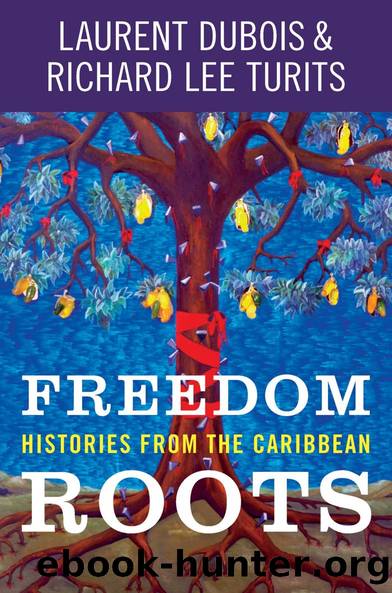Freedom Roots by Laurent Dubois Richard Lee Turits

Author:Laurent Dubois, Richard Lee Turits [Laurent Dubois, Richard Lee Turits]
Language: eng
Format: epub
Tags: History, Caribbean & West Indies, General, Cuba
ISBN: 9781469653617
Google: 2XC1DwAAQBAJ
Publisher: UNC Press Books
Published: 2019-10-11T03:43:17+00:00
Rebellion in the Cities
Batistaâs regime also faced a growing rebellion in the cities. At the start of 1957, armed resistance escalated in Santiago, Havana, and other cities. The urban wing of the 26th of July Movement set off bombs on a weekly basis. Instead of arresting and trying suspected rebels, the police and army shot suspects and political opponents on the spot. All constitutional guarantees were suspended, as Batistaâs forces arrested, tortured, and killed not only suspected revolutionaries but also critics in the two main political parties, the Authentic and Orthodox Parties. Batistaâs violent repression only spurred further protest. In early January 1957, more than five hundred self-described âCuban mothersâ dressed in black marched through Santiago brandishing the banner âStop the murders of our children!â The march was led by a woman whose teenage son, William Soler, had been tortured and murdered by police who suspected him of working with the 26th of July Movement. This was one of many marches and other protests in which women played a central role, deploying what Michelle Chase has called a âcreative repertoire of dissentâ that included âphone chains and rumor campaigns, collective âstay at homeâ days, âflashâ protests, patriotic street theater,â and boycotts. These actions played a pivotal role in mobilizing and broadcasting the anti-Batista sentiments that the 26th of July Movement was channeling into an armed revolutionary campaign.55
Overall women represented a large part of the urban resistance, both violent and nonviolent. They transported weapons, troops, and messages to the guerrillas in the mountains. They also carried out espionage against the Batista regime, for instance, when telephone operators listened in on regime officials or sex workers discovered information from clients linked to the regime. Women distributed revolutionary leaflets, provided safe houses for rebels, and collected money for the resistance. They also built and detonated bombs. In response, the regime cracked down increasingly hard, subjecting women, like men, to beatings and torture, even when women were peacefully protesting police killings or mourning in funeral processions. This repression, in turn, generated further popular outrage against the regime.56
As state violence and the country overall appeared increasingly out of control, new groups began to support overthrowing Batista through armed struggle. The professional classes, particularly the old Orthodox Party members, came more and more to accept Castro. One of the Orthodox Partyâs former leaders, Raúl Chibás (the brother of the partyâs founder, Eduardo Chibás), founded the Civic Resistance in Havana in early 1957, which was made up of middle- and upper-class individuals opposed to the regime. The Civic Resistance began collaborating with the more radical 26th of July Movement, sending it supplies and money and expanding its base of support.57
The most ambitious action in early 1957 was carried out by the Revolutionary Directorate, a group formed the year before by university students in Havana and driven by young middle-class opponents of the Batista regime. The Directorateâs founder, José Antonio EcheverrÃa, had earlier expressed hope that overthrowing Batista would lead not only to a democratic government but to
Download
This site does not store any files on its server. We only index and link to content provided by other sites. Please contact the content providers to delete copyright contents if any and email us, we'll remove relevant links or contents immediately.
| Antigua | Bahamas |
| Barbados | Cuba |
| Dominica | Dominican Republic |
| Grenada | Haiti |
| Jamaica | Saint Kitts |
| Saint Lucia | Saint Vincent |
| Trinidad and Tobago |
Cat's cradle by Kurt Vonnegut(13919)
Pimp by Iceberg Slim(12964)
Underground: A Human History of the Worlds Beneath Our Feet by Will Hunt(11283)
4 3 2 1: A Novel by Paul Auster(11092)
The Radium Girls by Kate Moore(10937)
American History Stories, Volume III (Yesterday's Classics) by Pratt Mara L(4831)
Perfect Rhythm by Jae(4636)
Wiseguy by Nicholas Pileggi(4620)
The Fire Next Time by James Baldwin(4360)
Paper Towns by Green John(4186)
A Higher Loyalty: Truth, Lies, and Leadership by James Comey(4049)
Pale Blue Dot by Carl Sagan(4029)
The Mayflower and the Pilgrims' New World by Nathaniel Philbrick(3924)
The Doomsday Machine by Daniel Ellsberg(3745)
Too Much and Not the Mood by Durga Chew-Bose(3706)
Killers of the Flower Moon: The Osage Murders and the Birth of the FBI by David Grann(3638)
The Borden Murders by Sarah Miller(3600)
The Sympathizer by Viet Thanh Nguyen(3537)
Killing England by Bill O'Reilly(3471)
